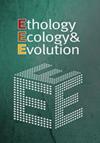Mechanisms of collateral damage: heterospecific neighbor density mediates parasitism by eavesdroppers on hourglass treefrogs
IF 1.1
4区 生物学
Q4 BEHAVIORAL SCIENCES
引用次数: 3
Abstract
Males often broadcast conspicuous signals from within mixed-species aggregations to attract mates. In addition to attracting females, however, these displays expose signalers to eavesdropping predators and parasites. For individuals in mixed-species aggregations, the balance between attracting mates and avoiding eavesdroppers is influenced both by the attractiveness of their calls and by the calling activity of conspecific and heterospecific neighbors. Through a process termed “collateral damage”, frogs signaling near heterospecific neighbors that are highly attractive to eavesdroppers can experience drastically increased parasitism compared to those signaling next to conspecifics. Here, we investigate whether the intensity of this collateral damage is influenced by the density of, or the call types produced by, heterospecific neighbors. In phonotaxis trials using hourglass treefrogs as the focal species and túngara frogs as the attractive heterospecific neighbor, we found no differences in the number of parasites attracted to hourglass treefrog calls played adjacent to simple versus complex túngara calls. By contrast, a higher density of neighboring túngara frogs decreased the collateral damage suffered by hourglass treefrogs by approximately 40%. Our results demonstrate that the density of nearby heterospecifics can modulate parasitism risk due to collateral damage in mixed-species aggregations. Thus, our conception of the dilution of eavesdropper risks with increasing group size may need to be augmented to include the effects of multiple prey or host types. HIGHLIGHTS ● Heterospecific call type does not change collateral damage on hourglass treefrogs ● However, parasitism decreases when calling next to high densities of heterospecifics附带损害机制:异种邻居密度介导偷听者对沙漏树蛙的寄生
雄性经常在混合物种群体中发出明显的信号来吸引配偶。然而,除了吸引雌性之外,这些展示还将信号暴露给偷听的捕食者和寄生虫。对于混合物种群体中的个体来说,吸引配偶和避免窃听者之间的平衡既受到其叫声的吸引力的影响,也受到同种和异种邻居的叫声活动的影响。通过一个被称为“附带损害”的过程,青蛙在异种邻居附近发出信号,这些邻居对窃听者非常有吸引力,与那些在同种邻居附近发出信号的青蛙相比,它们会经历急剧增加的寄生。在这里,我们研究了这种附带损害的强度是否受到异种邻居的密度或产生的呼叫类型的影响。在以沙漏树蛙为焦点物种,túngara蛙为吸引的异种邻居的致音性试验中,我们发现沙漏树蛙在简单和复杂túngara叫声附近播放的叫声所吸引的寄生虫数量没有差异。相比之下,邻近túngara蛙的密度越高,沙漏树蛙遭受的附带伤害就会减少约40%。我们的研究结果表明,由于混合物种聚集的附带损害,附近异种的密度可以调节寄生风险。因此,随着群体规模的增加,我们对窃听者风险的稀释的概念可能需要扩大,以包括多种猎物或宿主类型的影响。●异种呼叫类型不会改变沙漏树蛙的附带伤害,但是,当在高密度的异种呼叫时,寄生率会降低
本文章由计算机程序翻译,如有差异,请以英文原文为准。
求助全文
约1分钟内获得全文
求助全文
来源期刊

Ethology Ecology & Evolution
生物-动物学
CiteScore
3.10
自引率
0.00%
发文量
44
审稿时长
>12 weeks
期刊介绍:
Ethology Ecology & Evolution is an international peer reviewed journal which publishes original research and review articles on all aspects of animal behaviour, ecology and evolution. Articles should emphasise the significance of the research for understanding the function, ecology, evolution or genetics of behaviour. Contributions are also sought on aspects of ethology, ecology, evolution and genetics relevant to conservation.
Research articles may be in the form of full length papers or short research reports. The Editor encourages the submission of short papers containing critical discussion of current issues in all the above areas. Monograph-length manuscripts on topics of major interest, as well as descriptions of new methods are welcome. A Forum, Letters to Editor and Book Reviews are also included. Special Issues are also occasionally published.
 求助内容:
求助内容: 应助结果提醒方式:
应助结果提醒方式:


